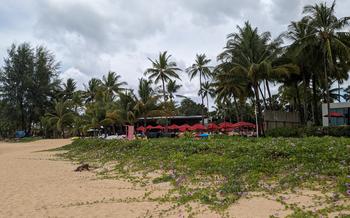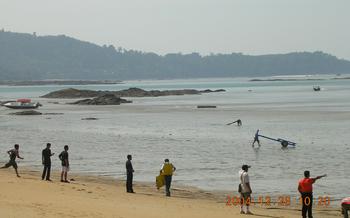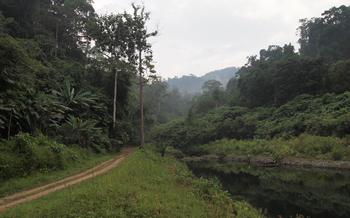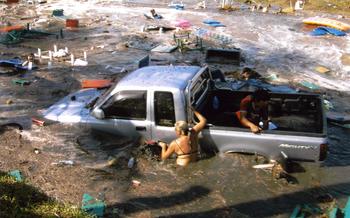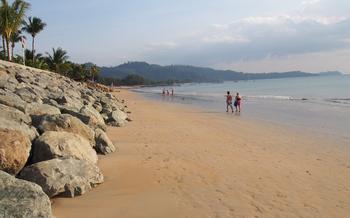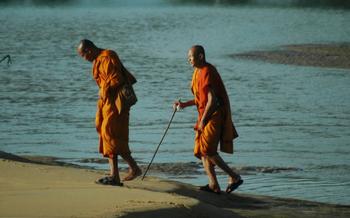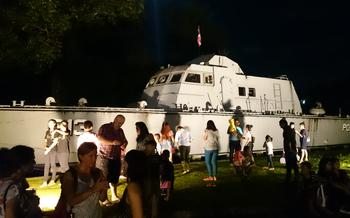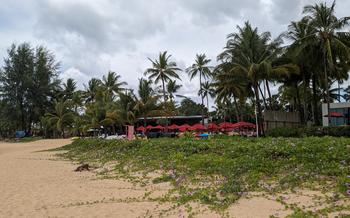
International Tsunami Museum
- Historical Background
- Location and Accessibility:
- Educational Exhibits
- Personal Stories
- Tsunami Science
- Tsunami Warning Systems
- Evacuation Routes
- Memorial Garden: A Place of Remembrance
- Interactive Workshops
- Volunteer Opportunities
- Accessibility for All
- Guided Tours
- Visitor Tips
- Insider Tip:
Historical Background
The International Tsunami Museum in Khao Lak stands as a solemn reminder of the devastating Indian Ocean tsunami that struck on December 26, 200This catastrophic event, triggered by a massive earthquake off the coast of Sumatra, Indonesia, unleashed a series of destructive waves that swept across the Andaman Sea, leaving an indelible mark on the coastal communities of Thailand, including Khao Lak. The tsunami's impact was profound, causing widespread devastation and loss of life. The International Tsunami Museum serves as a poignant tribute to the victims of this tragedy, while also providing a platform for education and awareness about tsunamis and their devastating effects.
Location and Accessibility:
The International Tsunami Museum is conveniently situated in the heart of Khao Lak, a coastal town heavily affected by the 2004 tsunami. Its exact location is at 888 Phetkasem Road, Tambon Khuekkhak, Amphoe Takua Pa, Phang Nga 82190, Thailand. To get to the museum from Khao Lak, visitors can take a short tuk-tuk or taxi ride. It is also easily accessible by car or motorbike, with ample parking available on-site. The museum's prime location makes it easily accessible for both local residents and tourists, ensuring that its important message reaches a wide audience.
Educational Exhibits
The International Tsunami Museum engages visitors with a variety of interactive exhibits that bring the science and impact of tsunamis to life. Through multimedia displays, visitors can explore the causes, effects, and aftermath of tsunamis, gaining a deeper understanding of these devastating natural events.
One of the highlights of the museum is the interactive tsunami simulator, which allows visitors to experience the power of a tsunami firsthand. By simulating the movement of water and the force of a wave, the simulator provides a visceral understanding of the destructive force of tsunamis.
Other exhibits showcase the science behind tsunamis, explaining the geological and oceanographic factors that contribute to their formation. Visitors can learn about the different types of tsunamis, their propagation across the ocean, and the factors that influence their height and impact.
Through these educational exhibits, the International Tsunami Museum offers visitors a comprehensive and immersive learning experience, fostering a greater understanding of tsunamis and the importance of preparedness.
Personal Stories
The museum gives a platform to the survivors of the tsunami to share their harrowing tales. These stories are not just limited to the horrors of that fateful day but also encapsulate the resilience, hope, and unity that emerged in the aftermath. Through these personal accounts, visitors gain a deeper understanding of the human toll of the disaster and the remarkable spirit of those who lived through it.
Listening to these stories is not just about learning about the past; it's about connecting with the human experience on a profound level. These narratives remind us of our capacity for both suffering and compassion, emphasizing the importance of empathy and unity in the face of adversity. By sharing their stories, the survivors become beacons of hope and inspiration, reminding us that even in the darkest of times, the human spirit can prevail.
Tsunami Science
The museum delves into the scientific principles governing tsunamis, providing visitors with a solid grasp of these natural phenomena. Interactive exhibits and displays illustrate how tsunamis are generated, how they propagate across oceans, and how their impact varies based on factors like water depth, coastal topography, and the nature of the triggering event. Visitors learn about the different types of tsunamis, including those caused by earthquakes, submarine landslides, volcanic eruptions, and meteorite impacts. The museum also highlights recent scientific advancements in tsunami detection and prediction, shedding light on the challenges and opportunities in this field. By fostering a deeper understanding of tsunami science, the museum empowers visitors to make informed decisions and take appropriate actions in the face of these natural hazards.
Tsunami Warning Systems
The International Tsunami Museum plays a crucial role in educating visitors about the importance of tsunami warning systems. These systems are designed to provide early warnings to coastal communities in the event of an impending tsunami, allowing them to evacuate to safety. The museum showcases the various types of warning systems in place in Thailand, including the National Tsunami Warning Center and the Indian Ocean Tsunami Warning and Mitigation System (IOTWMS). These systems utilize a combination of seismic data, tide gauges, and deep-ocean pressure sensors to detect and monitor tsunamis in real-time.
The museum also emphasizes the importance of public awareness and education regarding tsunami warning systems. It highlights the need for coastal communities to be familiar with the different warning signals, evacuation routes, and safety procedures. By understanding how these systems work and how to respond to warnings, individuals can significantly increase their chances of survival in the event of a tsunami.
Evacuation Routes
In the unfortunate event of a tsunami warning, it is crucial to know the evacuation routes in Khao Lak. The museum provides detailed information on these routes, ensuring that visitors are well-informed and prepared. These routes have been carefully planned to lead to higher ground or designated evacuation centers, maximizing safety during an emergency. It is advisable to familiarize yourself with these routes before exploring the area, paying attention to signage and local instructions. Knowing the evacuation routes and practicing them regularly can make all the difference in ensuring your safety and that of your loved ones in the face of a tsunami.
Memorial Garden: A Place of Remembrance
The International Tsunami Museum features a serene and poignant memorial garden dedicated to the victims of the 2004 Indian Ocean tsunami. Lush greenery, tranquil water features, and commemorative plaques create a contemplative space for visitors to pay their respects and remember those who lost their lives.
The memorial garden serves as a powerful reminder of the devastating impact of the tsunami on Khao Lak and its surrounding communities. Visitors can take a moment to reflect on the lives lost and the resilience of those who survived. The garden also provides an opportunity to learn more about the tsunami and its aftermath, fostering a sense of understanding and compassion.
As you wander through the memorial garden, you'll find a variety of commemorative elements that honor the victims and celebrate their lives. Plaques bearing the names of those who perished serve as a poignant reminder of the tragedy. Sculptures and artwork symbolize hope, renewal, and the enduring spirit of the human race.
The memorial garden is a place of peace and tranquility, offering visitors a chance to connect with the past and find solace in the midst of remembrance. It's a fitting tribute to those who were lost and a reminder of the importance of cherishing life and community.
Interactive Workshops
The museum offers a range of interactive workshops and activities that provide visitors with a hands-on learning experience. These workshops are designed to engage visitors of all ages and help them understand the science and impact of tsunamis in a more interactive and immersive way.
One popular workshop is the "Tsunami Simulator," where visitors can experience the power of a tsunami firsthand. This interactive exhibit uses a large water tank to create a simulated tsunami, allowing visitors to see and feel the force of the waves. The workshop also teaches visitors about the different factors that can affect the strength and impact of a tsunami, such as the size of the earthquake, the distance from the epicenter, and the underwater topography.
Another popular activity is the "Build Your Own Tsunami" workshop. In this workshop, visitors can create their own miniature tsunamis using a variety of materials, such as water, sand, and Lego blocks. This activity helps visitors understand the basic principles of tsunami formation and how different factors can affect the size and strength of a tsunami.
These interactive workshops are not only educational but also entertaining, making them a great way for visitors to learn about tsunamis and their impact in a fun and engaging way.
Volunteer Opportunities
The International Tsunami Museum offers visitors the opportunity to become involved in its mission through volunteer work. Volunteering at the museum is a rewarding experience that allows visitors to contribute to the preservation of tsunami history and education. Volunteers can assist with various tasks, such as leading tours, assisting with educational programs, or helping with research projects. By volunteering, visitors can not only gain valuable knowledge and skills but also make a positive impact on the community and help ensure that the lessons learned from the 2004 Indian Ocean tsunami are never forgotten.
The museum welcomes volunteers from all backgrounds and experience levels. Whether you are a student, a retiree, or simply someone with a passion for history and education, there is a volunteer opportunity that suits your interests and skills. To learn more about volunteering at the International Tsunami Museum, please visit the museum's website or contact the museum directly.
Accessibility for All
The International Tsunami Museum is committed to ensuring that everyone, regardless of ability, has a meaningful and enriching experience. The museum is wheelchair accessible, with ramps and elevators providing easy access to all exhibits. Additionally, the museum provides assistive listening devices and braille guides for visitors with hearing or visual impairments. Staff members are also trained to assist visitors with disabilities, providing guidance and support as needed. The museum's dedication to accessibility ensures that everyone can learn about the history of tsunamis and the importance of disaster preparedness.
Guided Tours
Guided tours of the International Tsunami Museum offer a deeper and more personalized experience for visitors. Led by knowledgeable guides, these tours provide insights into the museum's exhibits, the history of the tsunami, and the personal stories of survivors. Guides can answer questions, share additional information, and help visitors connect with the material on a deeper level.
To book a guided tour, visitors can contact the museum in advance or inquire at the ticket counter. Tours are available in various languages and can be customized to suit the interests of different groups. Whether you're a history buff, a science enthusiast, or simply someone looking to learn more about the devastating impact of the tsunami, a guided tour is highly recommended.
Visitor Tips
Planning a trip to the International Tsunami Museum requires minimal preparation. Dress comfortably and appropriately for the tropical climate, ensuring you have footwear suitable for walking on various surfaces. Expect to spend at least two hours exploring the exhibits and installations, allowing ample time to absorb the information and reflect on the experiences shared.
The museum offers various facilities to enhance your visit. Take advantage of the café to refuel with refreshments or enjoy a light meal. Browse the gift shop for souvenirs and educational resources related to tsunamis and disaster preparedness. Utilize the restrooms before embarking on your journey through the museum's exhibits.
If you have additional questions or require assistance during your visit, do not hesitate to approach the friendly and knowledgeable staff. They are dedicated to providing a welcoming and informative experience for all visitors.
Insider Tip:
One of the lesser-known secrets of the International Tsunami Museum is its rooftop terrace. While most visitors explore the exhibits inside, the terrace offers a unique perspective on Khao Lak and the surrounding area. From this vantage point, you can see the lush greenery of the hills, the sparkling Andaman Sea, and the bustling town below. It's a great spot to take a break from the museum's somber exhibits and enjoy the peaceful surroundings.
My personal recommendation for visitors is to plan your visit during the early morning or late afternoon to avoid the midday heat and crowds. This will allow you to fully immerse yourself in the museum's exhibits and take your time exploring the memorial garden. Remember to bring your camera to capture the stunning views from the rooftop terrace.
